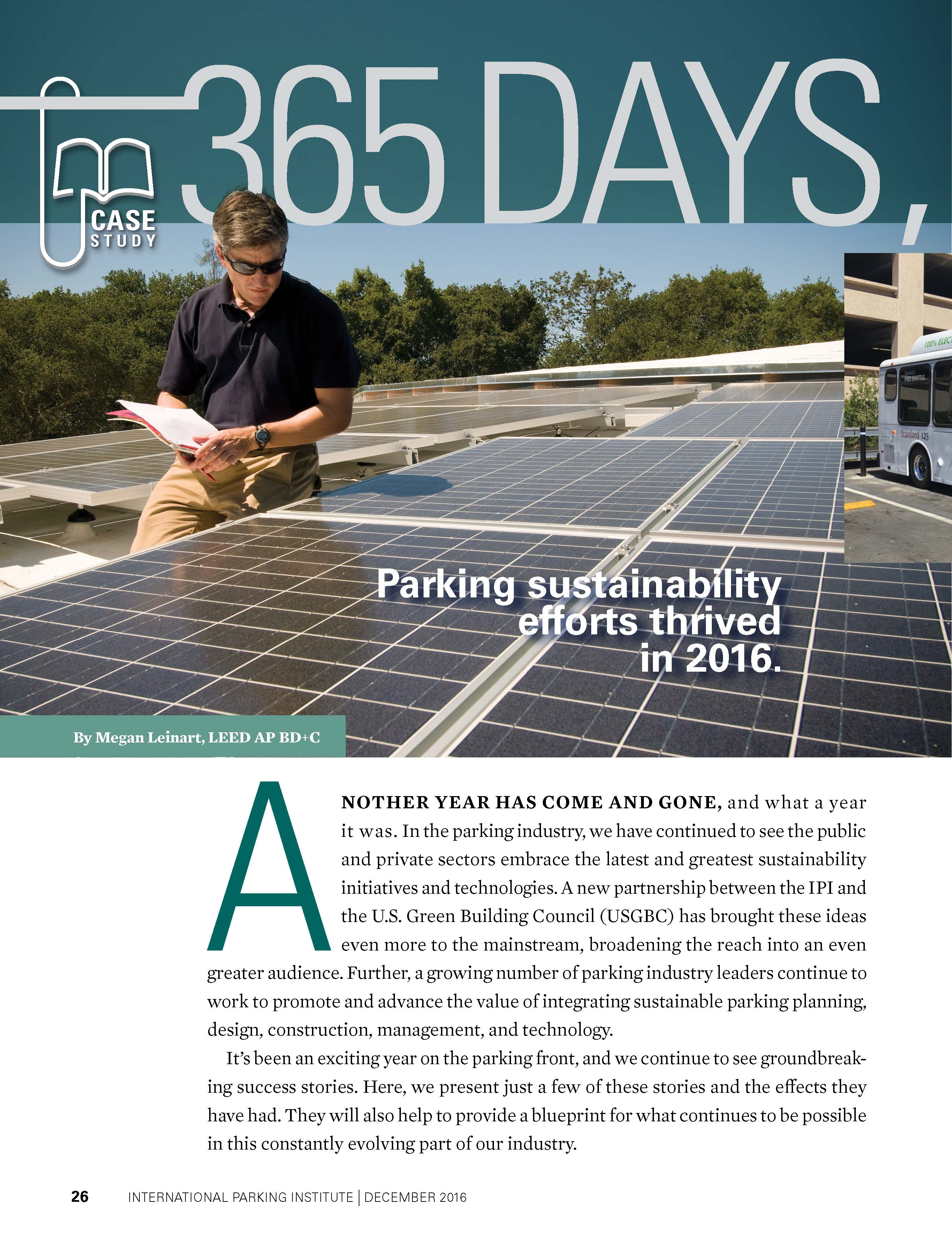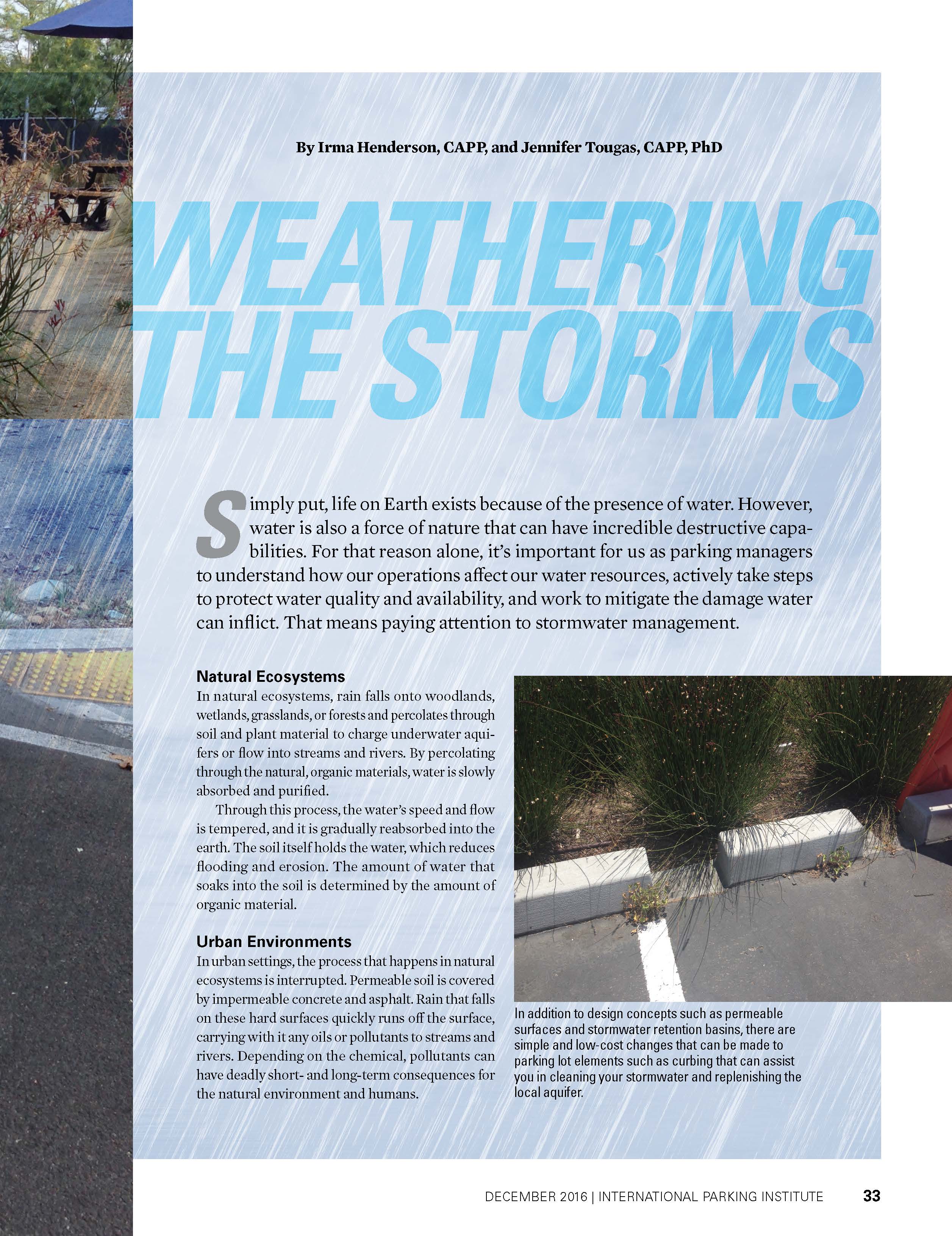365 Days Big Green
by Megan Leinart, LEED AP BD+C
Another year has come and gone, and what a year it was. In the parking industry, we have  continued to see the public and private sectors embrace the latest and greatest sustainability initiatives and technologies. A new partnership between the IPI and the U.S. Green Building Council (USGBC) has brought these ideas even more to the mainstream, broadening the reach into an even greater audience. Further, a growing number of parking industry leaders continue to work to promote and advance the value of integrating sustainable parking planning, design, construction, management, and technology.
continued to see the public and private sectors embrace the latest and greatest sustainability initiatives and technologies. A new partnership between the IPI and the U.S. Green Building Council (USGBC) has brought these ideas even more to the mainstream, broadening the reach into an even greater audience. Further, a growing number of parking industry leaders continue to work to promote and advance the value of integrating sustainable parking planning, design, construction, management, and technology.
It’s been an exciting year on the parking front, and we continue to see groundbreaking success stories. Here, we present just a few of these stories and the effects they have had. They will also help to provide a blueprint for what continues to be possible in this constantly evolving part of our industry.
Stanford University Energy System Innovation
Stanford University continues to be a leader in innovation and progress, particularly through the implementation of cutting-edge sustainability initiatives. One such initiative is the Stanford Energy System Innovation (SESI), which has transformed how energy is delivered to the campus to heat and cool its buildings. By using electricity purchased from renewable sources, the university will reduce its carbon emissions by 68 percent.
Stanford’s Parking & Transportation Services, a division of Sustainability & Energy Management, is contributing to SESI with two cutting-edge projects: electrification of the Marguerite bus yard and fleet and solar panel installation on the Stock Farm Garage.
Stanford’s Marguerite shuttle program has been expanding its use of electric buses on campus since 2014. The successful performance of the program’s initial 13 buses has led the university to acquire an additional 10. The university converted a portion of its existing bus yard to serve as the charging and storage facility for all 23 electric buses. This project was the first of a phased approach to convert the entire bus yard and adjacent parking lot into an electric charging facility for an eventual all-electric Marguerite bus fleet. This project also facilitated the installation of electric vehicle chargers in the adjacent Stock Farm Garage, doubling the charging capacity of that facility.
In addition, the university has installed solar panels on large rooftops across Stanford’s campus, including the Stock Farm Garage. While challenging, the payoff for this project will help the university meet its goal of reducing carbon emissions, supporting the electric bus fleet, and shading vehicles parked on the roof.
It’s Always Sunny in Arizona!
Arizona State University (ASU) is taking solar to the next level. The university has integrated three major solar panel installations that help not only power the university but significantly reduce fossil fuel consumption and emissions as well.
The solar installation generates a total wattage of more than 24.1 megawatts (MWdc) at 89 locations across all four campuses and the ASU Research Park. These installations, located in parking lots and on garage rooftops, also provide valuable shade to more than 5,900 parking spaces and 828 stadium seats—that’s a benefit that is always appreciated in the overpowering heat of the Southwest.
During 2015 at the Carson Student Athletic Center, the solar power plants located on ASU’s Tempe Campus facilities generated approximately 26,568 megawatt hours (MWh)—equivalent to 14 percent of the electricity used at Tempe Campus facilities. Concurrently that year, on ASU’s West Campus, the Sparky 10 MW installation generated approximately 8,595 MWh in 2015; this amount of energy is equivalent to 71 percent of the total amount of electricity used at ASU’s West Campus facilities.
The integration of the solar panels at ASU’s campuses showcases the significant effect solar power can have on meeting the energy needs on a campus, reducing the associated costs, as well as fossil fuel consumption and emissions. However, this program is also a testament to the important role parking can play in complementing this valuable energy source, providing wide open spaces for large installations while helping provide shade for vehicles and people.
Cincinnati Zoo Becomes First Demonstrator Site
The Cincinnati Zoo and Botanical Garden has been named the first Green Parking Lot Demonstrator site under a new USGBC program aimed at recognizing surface lots that exhibit exceptional sustainable design. This is part of a nearly decade-long effort at the zoo to implement a number of progressive initiatives through sustainability.
Upon arrival at the zoo, guests are greeted with a sea of sleek solar panel canopy that keeps vehicles cool and reduces the heat-island effect. In addition, the solar panels generate 1,700 MWh of electricity, equivalent to 20 percent of their usage, and eliminate 1,775 tons of carbon dioxide (CO2) emissions, which is equivalent to the reduction of approximately 3 million vehicle miles travelled annually.
Another groundbreaking feature of the Cincinnati Zoo parking lot is the significance of the landscaping features. Two large rain gardens, native plantings, and large shade trees provide natural beauty and alleviate stormwater issues. An underground cistern retains and slowly dissipates stormwater, relieving pressure on an aging wastewater infrastructure.
Patrons can use one of seven electric vehicle (EV) charging stations, including one DC fast charger, and bikers can dismount at the appropriately themed snake-shaped bicycle rack or take advantage of the Cincinnati Red bike sharing kiosk. For visitors looking to avoid traffic but who are not up for biking, the Cincinnati Metro Transit Agency drops off right inside the parking lot. Finally, the zoo’s vehicle fleet consists of emissions-free electric golf carts while trucks and the mini-rail are powered with recycled biodiesel.
The Cincinnati Zoo and Botanical Garden is at the cutting edge of a groundbreaking new program to recognize the many sustainable design opportunities available for parking lots and will serve as a model for similar projects in the future. Leading the way, Director of Facilities and Sustainability Mark Fisher engaged his staff, the city, public utilities, and property owners to find innovative solutions to their most pressing environmental problems and creatively implement them to meet their biggest needs, while educating the community.
Medical Group Embraces Lightwells
How do you create an inviting patient experience in a subterranean parking structure while reducing energy benefits? The Camino Medical Group faced this question when the parking structure for its Mountain View campus involved a subterranean level. The answer? Lightwells.
Lighting is not only an important consideration in the functional design of a parking garage but also a critical factor in the user experience. Dark, cramped structures feel unsafe and do not attract patrons; open, well-lit structures with good ventilation feel safe and secure and invite users.
Achieving natural light and air in structured parking often requires provisions such as lightwells. Lightwells or air shafts are unroofed external spaces provided within the volume of a large building to allow light and air to reach what would otherwise be a dark and less-ventilated area.
In a below-grade parking structure, lightwells can sometimes be achieved by surrounding the structure with permanent shoring walls or by sloping back the soil around the structure. In addition to providing user experience and functional benefits, lightwells have both economic and environmental benefits of reducing overall energy demands, as was the case for the Camino Medical Group Parking Structure, which utilized landscaped lightwells in addition to extra high ceilings and brighter-than-average lighting to make patients feel safe and secure.
Emory University Upgrades Its Lighting
Always one to make its mark as an innovator in the medical world, Emory University isn’t limiting innovation to medical procedures alone. The university recently mandated a cutting-edge lighting fixture to illuminate its underground garage, which services the new state-of-the-art campus hospital expansion project.
The university’s lighting consultant created the ECO Mantis™ lighting fixture, which features linear remote phosphor LEDs specifically designed to support the parking industry. The remote phosphor LED features near zero light output depreciation over time. By locating the heat sensitive phosphor away from the heat-generating LED chips, the phosphor maintains near 100 percent output over the life of the fixture.
The garage will provide much-needed parking in an active campus and is expected to be open to the public by year’s end.
San Francisco Building Upgrades Ventilation
Located in San Francisco’s financial district, 475 Sansome Street is a 21-story, Class A office building with an underground parking facility requiring mechanical ventilation 15 hours a day Monday through Friday. To reduce energy costs, the facility operator recently installed a “variable flow” demand-control ventilation system, which fluctuates garage exhaust and supply fan motor speeds based on carbon monoxide (CO) concentrations in the garage.
Prior to the control system installation, the garage’s ventilation motors consumed nearly 60,000 kilowatt hours (kWh) each year at a cost of more than $8,800. The installation of a variable flow demand-control ventilation system significantly reduced total energy consumption and costs.
Post-installation data showed that the new ventilation control system reduced the garage fan motors’ kWh consumption by more than 57,500 per year—a 96.5 percent savings. Peak kWh demand was reduced by 14.73 percent, also a 96.5 percent savings. The project’s net present value of $84,000 is nearly four times greater than the cost of the variable flow control system installation.
Megan Leinart, LEED AP BD+C, is national director of corporate development for Propark. She can be reached at megan.leinart@propark.com.
TPP 2016-12 365 Days Big Green
 By Shawn D. Conrad, CAE
By Shawn D. Conrad, CAE

 As mobility technologies and services, consumer preferences and behaviors, and transportation policies co-evolve over the coming decades, there is great uncertainty about both the pace of continued change and which mobility options will be adopted. A few things, however, are certain: as the world’s population grows and becomes wealthier, the demand for personal mobility, convenience, and flexibility will increase.
As mobility technologies and services, consumer preferences and behaviors, and transportation policies co-evolve over the coming decades, there is great uncertainty about both the pace of continued change and which mobility options will be adopted. A few things, however, are certain: as the world’s population grows and becomes wealthier, the demand for personal mobility, convenience, and flexibility will increase. By Matt Davis
By Matt Davis Signs that change messages as curb demand flexes, autonomous school buses that also deliver packages, car-free downtown cores, and friendly delivery robots are among the revelations a prominent futurist predicts for urban mobility in the not-too-distant future.
Signs that change messages as curb demand flexes, autonomous school buses that also deliver packages, car-free downtown cores, and friendly delivery robots are among the revelations a prominent futurist predicts for urban mobility in the not-too-distant future.



